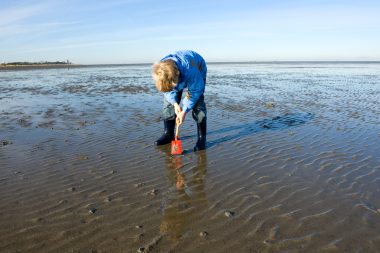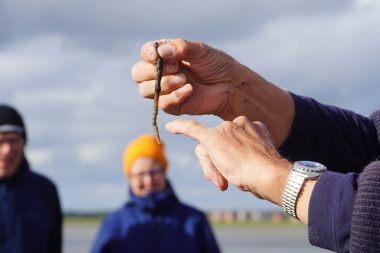Walking through the mudflats relaxes the mind and soul. See the endless expanse, feel the power of nature, enjoy the mud under your bare feet: For this alone, it is worth taking a walk through the mudflats. But the mudflats also have dangers in store, so a detailed mudflat hike should not be carried out without an experienced mudflat guide.
Wadden Sea as a place of learning
At first, you may not be thrilled when the water, for which you went to the sea, is gone, leaving only a dreary, muddy plain. But there are many reasons why this change of tides in particular can be enjoyed. Children are happy about the mud, in which they can muddy to their heart’s content. And the parents can also watch in a relaxed way, because it is quickly washed off as soon as the water comes back. But the Wadden Sea has much more to offer than silt – that’s the name of the grey mud. After all, the receding sea exposes the seabed, which can then be explored. And it is teeming with life, even if it is not recognizable at first glance.
The Wadden Sea was protected as a national park in 1985 and divided into 3 national parks:
- The Schleswig-Holstein Wadden Sea
- the Lower Saxony Wadden Sea
- and the Hamburg Wadden Sea.
It is also part of the UNESCO Biosphere Reserve and thus serves to preserve biological diversity. Because not only worms, mussels, snails and crabs live in the Wadden Sea. It is also a unique source of food for birds and serves as a breeding ground for them. For migratory birds, the Wadden Sea is an indispensable resting place on the way south. Many fish use the Wadden Sea to raise their young. You can get to know this and much more information on a mudflat hike. Where does the mussel get its name? What are those heaps on the ground? And what happens when you tickle a shell? Especially for families with children, the hike with a qualified mudflat guide is a real nature experience. But even as an adult, you always learn something new.
Mudflat hiking for young and old

There are different forms of mudflat hiking. Depending on fitness and group composition, different routes and guided tours can be booked. With children, a special family tour is recommended, which includes a shorter route and child-friendly information. A real experience for fit people is a tour from the mainland to an island or vice versa. Some islands can be reached on foot at low tide, but some physical fitness is a prerequisite, as there is only a certain amount of time available for the route before the water comes back. Depending on the tide (i.e. the tide), the day trip begins or ends with the mudflat hike and the rest of the day can be spent on the island or the mainland.
Equipment
The equipment depends on where and how far you want to hike. Suitable sun protection is particularly important when hiking through the mudflats. Due to the lack of shade, you are exposed to the sun for the entire time when the sky is cloudless, which also reflects on the wet seabed and can lead to severe sunburns. Sunscreen and a hat are therefore mandatory! Sunglasses with UV protection should also be carried.
But wind and cold must also always be taken into account. On the water, the weather changes quickly and in the mudflats you are completely unprotected, so a rain jacket should also always be in your luggage to protect against wind and moisture.
It is best to wear shorts on the mudflats, even if it is a little cooler. Because in some places you sink into the mud up to your knees, long pants that are then wet cool even more than bare legs.
Of course, the foot cover is important. The mudflats are teeming with shells and stones, which can lead to severe injuries due to their sharp edges. Therefore, either special cotton socks with a cut-proof coating on the underside or neoprene surf shoes should be worn. Rubber boots are rather unsuitable, because you can’t walk in them for long and they don’t fit tight enough and therefore get stuck in the silt. They also fill up quickly when you cross a tidal creek. It is best to ask directly when registering for the hike what the mudflat guide recommends. For shorter tours near the beach, old tennis socks are often sufficient, which you simply dispose of afterwards. A small plaster set for any injuries is also recommended.

If the tour is at the beginning of the day trip and a stay on the island or the mainland is planned afterwards, you should have spare clothes in a waterproof plastic bag with you. But a plastic bag is also worthwhile to transport dirty clothes afterwards, especially if you still have a car journey ahead of you. An old towel to dry the cleaned feet afterwards and something to drink should also not be missing. However, the backpack should not be heavier so that you can enjoy the hike. If in doubt, you should distribute the weight on the different shoulders. Children can also carry a towel and a water bottle in their backpack themselves.
If children are involved, a magnifying glass or binoculars are also good for the finds in the mudflats.
With the right equipment and a little curiosity, the mudflat hike is sure to be a success, will be remembered fondly and ensures relaxation of body and mind on holiday.




